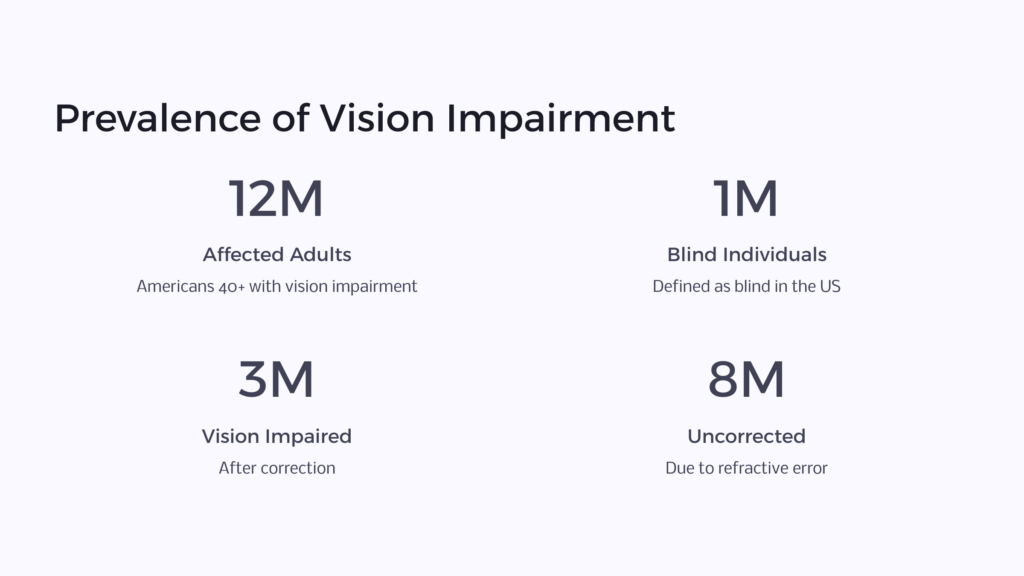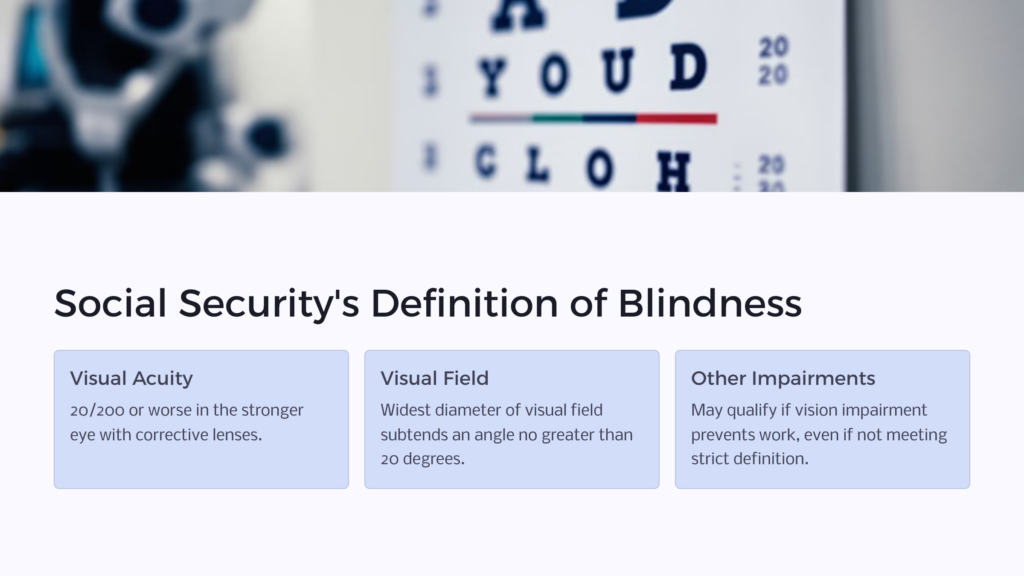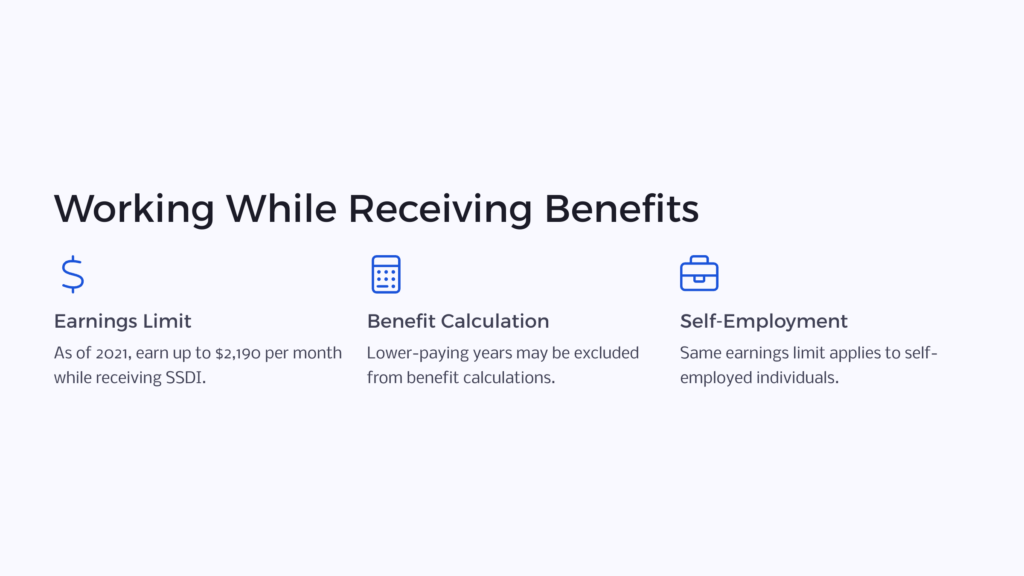Blindness is a disability that affects millions of people across the globe. It is a key qualification requirement in America for receiving Social Security Disability Insurance (SSDI) or Supplemental Security Income (SSI) benefits. SSI and SSDI benefits are an important financial safety net for blind individuals who may otherwise struggle to pay for basic expenses.

Top Causes of Blindness
- Diabetic Retinopathy
- Cataract
- Age-Related Macular Degeneration
- Corneal Opacity
- Trachoma
- Glaucoma
- Refractive Errors
According to the U.S. Centers for Disease Control and Prevention, approximately 12 million individuals ages 40 and above in the United States have some level of vision impairment. There are an estimated 1 million who are defined as blind, 3 million who have some level of vision impairment after correction, and 8 million who have vision impairment due to uncorrected refractive error.

The National Institute for Occupational Safety and Health (NIOSH) reports that each day approximately 2,000 U.S. workers suffer job-related eye injuries that require medical treatment. Currently, vision disabilities are one of the top 10 disabilities among American adults.
Those who are legally blind or who have significantly impaired vision may be eligible for financial support through both the SSDI and SSI federal benefits programs. The federal government recognizes the hardship faced by those with blindness or significantly impaired vision. Both programs exist to ease that burden by providing supplementary financial compensation.
How Does Social Security Define Blindness?

For SSI eligibility, blindness is defined as having a central visual acuity of 20/200 in the stronger eye, even with the use of a corrective lens, or having a visual field limitation in the stronger eye such that the widest diameter of the visual field subtends an angle of no greater than 20 degrees.
It is important to note that if you have a visual impairment that does not meet the strict definition of blindness from the SSA’s list of impairments, you still may qualify for SSI benefits based on disability. If your vision impairment, either on its own or in combination with other health conditions, keeps you from being able to work, you may be able to receive some level of disability compensation.
7 Top Causes of Blindness
While total blindness can be attributed to many sources, below are some of the most common causes of blindness.
Diabetic Retinopathy
Individuals who live with diabetes are at a statistically higher risk of suffering from eye problems, largely because of diabetic retinopathy. This eye condition results from the light-sensitive blood vessels within the retina being damaged by high blood sugar levels.
The result may be everything from pain in the eye to increasingly blurry vision. Diabetic retinopathy can develop in any patient with Type 1 or Type 2 diabetes. However, the longer a patient lives with diabetes and the less controlled the patient’s blood sugar, the more likely the patient is to develop diabetic retinopathy.
Symptoms may include floating spots in the field of vision, blurred vision, and vision loss. For diabetic patients, the most important risk factor is their blood sugar, so consistently managing blood sugar levels is an important protection against diabetic retinopathy.
Cataract
Cataracts occur when the lens of the eye loses its transparency, often resulting in foggy, cloudy eyesight and lending a milky appearance to the eyes. For patients with cataracts, the result is much like looking through a cloudy or frosted window. While cataracts are most common in patients over age 65, they often are a side effect of another medical condition, such as diabetes.
Cataract surgery is an effective treatment for cataracts and is a very common medical procedure. While cataracts don’t initially affect normal vision, they will begin to eventually, resulting in cloudy vision, difficulty seeing at night, increased sensitivity to light, and sometimes double vision. These issues can often be treated with corrective lenses at first, though many patients eventually find the need for surgery.
Age-Related Macular Degeneration
The causes of macular degeneration remain unclear, though it usually appears with advanced age. Blurred vision is its chief symptom. As the macula in the retina deteriorates over time, a patient will gradually lose central vision. Though linked to blindness, this eye condition is usually painless. However, due to its gradual progress, macular degeneration is often undetected until the disease is well advanced.
There is no cure currently for macular degeneration, though there is a range of treatments that can help preserve normal vision for as long as possible and improve quality of life.
Corneal Opacity
Corneal opacity occurs when the normally transparent cornea becomes scarred, preventing light from passing through the retina. The eye condition also may at times cause the cornea to appear white or cloudy.
This visual disorder may be caused by injury to the eye, infection, corneal scratching, or other abrasion or swelling of the eye. Available treatments include antibiotic or steroid eye drops, oral medications, phototherapeutic keratectomy, laser surgery, and in the most serious cases, cornea transplant.
Trachoma
Trachoma is caused by the bacterium Chlamydia trachomatis and represents the world’s most prolific cause of preventable blindness of infectious origin. The eye infection is reportedly extremely painful. Trachoma often permanently damages the cornea and can lead to irreversible total blindness.
Trachoma typically spreads quickly in areas lacking access to clean water and sanitation, meaning it affects the most marginalized communities in the world. Nearly 8 million individuals across the globe have been left visually impaired by trachoma. Another 500 million people are at risk of blindness from the disease throughout 57 countries.
Glaucoma
When a buildup of fluid behind the eye causes pressure and pain around the optic nerve, this condition is known as glaucoma. Glaucoma can occur at any age, though it’s more common in older individuals. It is one of the leading causes of vision impairments for individuals over age 60.
Symptoms may include anything from patchy blind spots and tunnel vision to severe headaches, nausea, and eye pain. Glaucoma is treated in several different ways, and early detection and treatment can prevent the condition from causing irreversible damage to the eye.
Refractive Errors
Refractive errors include conditions like myopia, hyperopia, or astigmatism, all of which can cause vision impairment to various degrees. A refractive error means that the natural shape of the eye keeps light from landing appropriately on the retina for clear vision.
Refractive errors represent the most common vision problem, affecting more than 150 million Americans. Fortunately, many of these conditions can be successfully managed by appropriate corrective lenses – and in some cases, laser surgery.
Can I Get Disability Benefits for Blindness?

In many cases, you can be awarded disability SSDI benefits for blindness if you have earned sufficient work credits. Many times, even if someone doesn’t have enough work credits to qualify on their own, they also may be able to qualify based on the work credits of a spouse. If you are legally blind but still able to work, you may be able to choose a disability freeze, which opens the opportunity for higher retirement or disability benefits at a point in the future when you begin to receive SSD benefits.

If your earnings have been reduced because of your blindness, the Social Security Administration can exclude the lower-paying years of your employment when calculating your Social Security retirement or disability benefits at a future date. Since Social Security benefits are calculated based on average lifetime earnings, your benefit amount will be higher as a result of excluding those lower-paying years.
You also are allowed to work while receiving SSDI benefits for disability, as long as your earnings fall below a threshold specified by law. As of 2021, you could earn as much as $2,190 per month and still receive SSDI benefits. This limit also applies to those who are self-employed.
Unlike SSDI benefits, Supplemental Security Income benefits for blindness are based primarily on income and available resources and have nothing to do with your work history. In other words, you do not have to have worked a minimum amount or earned a minimum number of work credits to qualify for SSI benefits.
You may also be eligible for some level of disability for blindness even if your eye condition does not meet the strict SSA definition of blindness. To be eligible for Social Security disability benefits, you must have worked long enough in a job where you paid Social Security taxes and earned sufficient work credits.
For SSI benefits based on disability and blindness, there is no work requirement but your income and resources must be under a certain poverty threshold.
Social Security Services for the Blind
Some Social Security services are designed specifically for those who are legally blind or have impaired or low vision. For example, the following special services are available when it comes to how you receive notices from the Social Security Administration:
- A standard-print notice delivered by first-class mail
- A standard-print notice delivered by certified mail
- A standard print notice delivered by first-class mail, with a follow-up telephone call
- A Braille notice, along with a standard-print notice, delivered by first-class mail
- A Microsoft Word file delivered on a CD, along with a standard-print notice delivered by first-class mail
- An audio CD, along with a standard-print notice delivered by first-class mail
- A large-print (18-point font) notice, along with a standard-print notice delivered by first-class mail
You can notify the SSA of your preference by visiting their website and following the instructions. You can also call 1-800-772-1213 or the SSA’s TTY number at 800-325-0778 if you are deaf or hard of hearing. You can also write or visit your local Social Security office to communicate your preference.
What Eye Problems Qualify for Disability?
While there is no specific list of eye problems that automatically qualify for disability benefits, there are several eye conditions that, if they meet certain criteria, can potentially qualify for benefits:
1. Blindness: Complete blindness or significantly impaired vision in both eyes.
2. Visual Impairment: Severe visual impairments that cannot be corrected with glasses or contact lenses.
3. Macular Degeneration: Advanced stage of macular degeneration resulting in severe visual loss.
4. Glaucoma: Advanced stage of glaucoma causing significant visual field loss or optic nerve damage.
5. Diabetic Retinopathy: Severe retinal damage due to diabetes, leading to significant vision loss.
6. Retinitis Pigmentosa: Progressive degeneration of the retina, leading to severe visual impairment.
7. Cataracts: Advanced cataracts that significantly impact visual acuity and cannot be corrected with surgery.
8. Retinal Detachment: Complete or partial detachment of the retina causing severe vision loss.
9. Optic Neuritis: Inflammation of the optic nerve leading to significant visual impairment.
10. Corneal disorders: Severe corneal diseases or dystrophies resulting in substantial visual impairment.
11. Nystagmus: Involuntary eye movements causing significant vision disturbances.
12. Retinopathy of prematurity: Severe visual impairments in premature infants due to abnormal retinal development.
13. Uveitis: Chronic inflammation of the uvea causing significant visual impairment.
14. Hereditary eye disorders: Severe genetic eye conditions such as retinitis pigmentosa, achromatopsia, or albinism.
15. Severe Trauma or Injury: Eye injuries resulting in irreversible visual impairment.
16. Ocular melanoma: Malignant tumor of the eye, specifically the uvea or conjunctiva, which can lead to vision loss or impairment if it affects critical structures.
17. Hemianopia: A visual field loss affecting half of the visual field in both eyes, resulting from damage to the optic pathways or brain regions responsible for vision.
18. Sjögren’s Syndrome: An autoimmune disorder that primarily affects the exocrine glands, including those that produce tears. Severe cases of Sjögren’s syndrome can cause significant dryness of the eyes (keratoconjunctivitis sicca) and may impact vision.
Disability Benefits for Blindness
Vision impairments and blindness have a profound effect on a person’s quality of life, including their ability to work.
For Americans who are affected by blindness and/or extreme vision loss, the SSDI and SSI programs represent a key lifeline to maintaining financial viability and health. If you are suffering from vision impairment, find out today if you are eligible for SSDI or SSI benefits.
 Benefits.com Advisors
Benefits.com Advisors
With expertise spanning local, state, and federal benefit programs, our team is dedicated to guiding individuals towards the perfect program tailored to their unique circumstances.
Rise to the top with Peak Benefits!
Join our Peak Benefits Newsletter for the latest news, resources, and offers on all things government benefits.




















